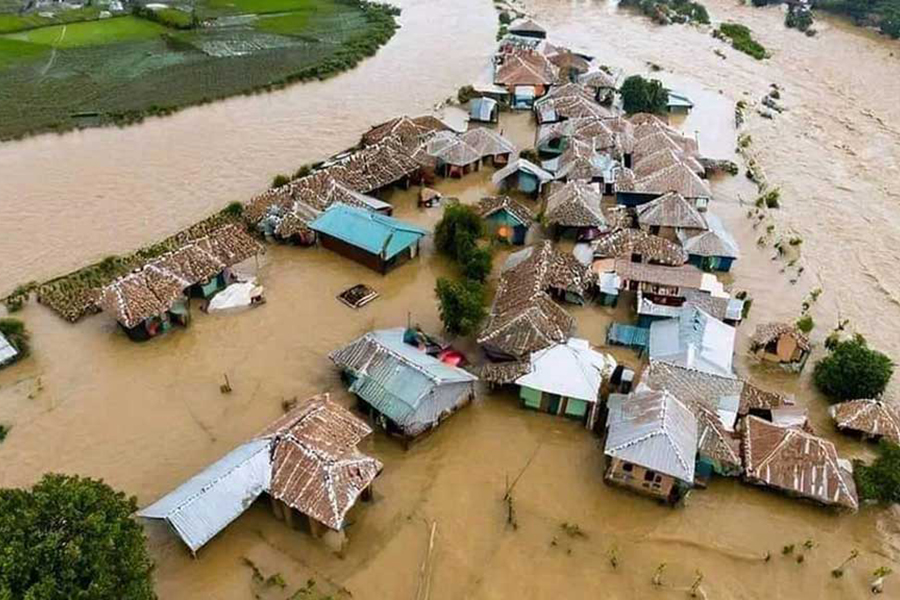
Published :
Updated :

The Bangladesh Meteorological Department has described the intense flooding in 11 districts near the end of August as ‘flash floods’.
Such floods usually inundate a wide area quickly, but the water usually recedes quite swiftly too.
However, this year’s flash floods are not retreating with the same speed. Districts like Feni were flooded a week ago, but the water has yet to drain away. Even in the areas where the water levels are on the decline, the pace of the ebbing is slow.
Discussions with meteorologists and climate experts revealed four main reasons for the flooding situation remaining largely unchanged until Sunday.
They say that simultaneous heavy rains in the Chattogram Division and the neighbouring Indian state of Tripura, the high level of mountain runoff, the tidal levels in the ocean, and the persistent rain in flooded areas has led to the extended flooding.
For these reasons, the floodwater has not receded after a week. Even on Sunday, little improvement could be seen.
According to the Water Development Board’s Flood Forecasting and Warning Centre, flood-affected areas saw the waters recede by an average of 20-30 cm between 9am and 6pm on Sunday.
Sardar Uday Raihan, the centre’s executive engineer, said: “This rate of decline can be described as slow to moderate. It is slower than the rate of water receding in other flash floods.”
Raihan noted two main reasons for the slow retreat of the water.
“One reason is that, the floods that happened in our country due to intense rain for the past three or four days also happened upstream. For this reason the water leaving the plains is leaving at a slow rate.”
“Another reason is that it is still raining. It is not as intense as before, but it is still raining. As a result, though the water is receding, it is not declining quickly.”
However, Raihan said the waters are likely to start retreating at a faster pace from Tuesday.
The water levels of the rivers reflected Raihan’s analysis. Many were still flowing above their danger levels. In some places, like Chattogram’s Mirsarai Upazila, the water is rising. There are reports of rising water in four of its unions on Sunday as well.
According to data from the FFWC, the Kushiyara River was flowing 13 cm above its danger point at 9am on Sunday. The water level only dropped by 1 cm over 24 hours.
The Kushiyara was also flowing 3 cm above the danger point at the Sherpur-Sylhet point and 2 cm above it at the Markuli point. However, the water levels at these points have dropped by 6 cm and 2 cm respectively over the past 24 hours.
The FFWC says that the Manu River was flowing 23 cm above the danger line at the Moulvibazar point at 9am on Sunday, but the water had dropped by 68 cm over the past 24 hours.
The Gomti River is flowing 78 cm over the danger line in Cumilla, but in the 24 hours to Sunday morning, the water level had dropped by 18 cm.
Rain was recorded in several districts on Sunday. Between 9am and 6pm, Teknaf saw 35 mm of rain, Naikhongchhari 24 mm, Lama 15 mm, Anowara 19 mm, and Noakhali 12 mm.
Feni is one of the districts worst hit by this round of flooding. Many parts of the district, including the Sadar town and other major population centres, are still inundated.
Of the 653 mobile communication towers in the area, 588 are still out of order. Despite ongoing efforts, these towers could not be made operational because of the strong water currents and lack of power. The disaster has hit the road network too.
In many ways, Feni is cut off from the rest of the country. For this reason, the WDB does not have any information on the Muhuri River, the overflowing of which led to the widespread flooding.
The other districts affected by the floods are Noakhali, Lakshmipur, Cumilla, Brahmanbaria, Chattogram, Khagrachhari, Habiganj, Moulvibazar, Sylhet, and Cox’s Bazar.


 For all latest news, follow The Financial Express Google News channel.
For all latest news, follow The Financial Express Google News channel.